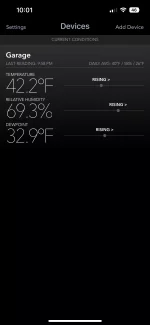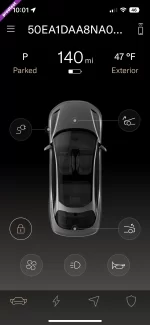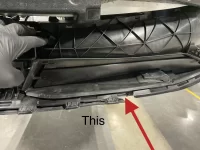-
Lucid Gravity Reservation Tracker: Add Your Gravity Reservation
You are using an out of date browser. It may not display this or other websites correctly.
You should upgrade or use an alternative browser.
You should upgrade or use an alternative browser.
Cold weather Cabin Temperature
- Thread starter niejelow
- Start date
- Joined
- Nov 18, 2021
- Messages
- 237
- Reaction score
- 54
- Location
- Connecticut, Keywest, Lugano
- Cars
- Lucid Air Dream P
- Air DE Number
- 45
Why are you even in this sight!!I had a SAAB 9000. The optimal temperature was 69°F, but the thermostats was calibrated in Centigrade, so you go 20° or 21°C. It was a butch. My Lexus Hybrid had a certain temp … I can’t remember it now.
My [current] 2018 Audi Q7 seems to like 75, though after awhile, 72 is more appropriate and, if I’m wearing a heavier coat, 69°F.
Ladies and gentlemen, car thermostats were never meant to be absolute. [For my fellow physicians, it’s like monitoring CVP: Changes are significant, but absolutes are not.]
I’m looking towards an Air Grand Touring in burgundy and tan interior. I had a Camry that was burgundy and grey, and it doesn’t work after awhile. Plus they have to prove their superiority to T***a. I’ll give them two to three years. Not willing to put a deposit down yet, but in a year or two. I don’t want to be stuck with a DeLorean or, lord help us, an Edsel.
Hi - getting colder in Northeast now - noticing a cold draft in the cabin at speeds above 60mph - emanating from driver window I believe. No sound - but put hand to top of window- very noticeable cold air coming through. Rectified by putting heat up to 78 and blowers at 6, but shouldn't have to do. Anyone else notice this?
Hi - getting colder in Northeast now - noticing a cold draft in the cabin at speeds above 60mph - emanating from driver window I believe. No sound - but put hand to top of window- very noticeable cold air coming through. Rectified by putting heat up to 78 and blowers at 6, but shouldn't have to do. Anyone else notice this?
I'm feeling like there's a little more wind noise at a lower speed than when the weather was hotter. I wouldn't get much wind noise during warm weather until I hit about 80 to 85 mph but now I'm noticing it around 75. But no draft. I'd wonder if some of the stripping is contracting on your car and letting cold air in. Would an infrared thermometer work to localize the source?
As for temps in the car, I find that I'm comfortable with the car at 70F, but I run our ICE at about 68F. Also the seat heaters are amazing like a warm embrace. And the heated steering wheel works almost too well. However, the external temps have only been in the low 30s so far in Boston. It's been a very balmy December.
Hi - getting colder in Northeast now - noticing a cold draft in the cabin at speeds above 60mph - emanating from driver window I believe. No sound - but put hand to top of window- very noticeable cold air coming through. Rectified by putting heat up to 78 and blowers at 6, but shouldn't have to do. Anyone else notice this?
I posted earlier my theory on conductive heat loss of the glass canopy. If I have some free time I'll make a insulated glass roof cover to test my theory.
- Joined
- Nov 18, 2021
- Messages
- 237
- Reaction score
- 54
- Location
- Connecticut, Keywest, Lugano
- Cars
- Lucid Air Dream P
- Air DE Number
- 45
I agree that the glass canopy dissipates heat. However it feels more like a draft once under way. In addition thermal conductivity through the canopy would not be that fast. As to the other post of wind noise it’s not wind noise it’s the tires as the are summer rated not winter rated. Thus the tire material composition changes during cold weather.I posted earlier my theory on conductive heat loss of the glass canopy. If I have some free time I'll make an insulated glass roof cover to test my theory.
- Joined
- Nov 18, 2021
- Messages
- 237
- Reaction score
- 54
- Location
- Connecticut, Keywest, Lugano
- Cars
- Lucid Air Dream P
- Air DE Number
- 45
I forgot to mention turn on the rear heating and it will balance the cabin temperature out more evenly. The rear is always turned off and needs to be manually engaged.I'm feeling like there's a little more wind noise at a lower speed than when the weather was hotter. I wouldn't get much wind noise during warm weather until I hit about 80 to 85 mph but now I'm noticing it around 75. But no draft. I'd wonder if some of the stripping is contracting on your car and letting cold air in. Would an infrared thermometer work to localize the source?
As for temps in the car, I find that I'm comfortable with the car at 70F, but I run our ICE at about 68F. Also the seat heaters are amazing like a warm embrace. And the heated steering wheel works almost too well. However, the external temps have only been in the low 30s so far in Boston. It's been a very balmy December.
I forgot to mention turn on the rear heating and it will balance the cabin temperature out more evenly. The rear is always turned off and needs to be manually engaged.
Does anyone know if it turns on when you use remote climate?
Hi, @Neuner89.Hi - getting colder in Northeast now - noticing a cold draft in the cabin at speeds above 60mph - emanating from driver window I believe. No sound - but put hand to top of window- very noticeable cold air coming through. Rectified by putting heat up to 78 and blowers at 6, but shouldn't have to do. Anyone else notice this?
Thank you for sharing. I DM'd you for additional information.
Marqie
- Joined
- Feb 12, 2022
- Messages
- 413
- Reaction score
- 363
- Location
- Brecksville, Ohio
- Cars
- Lucid Air Touring
Hi @Neuner89 , I have this as well in cold weather, was service able to fix this for you?
- Joined
- Nov 18, 2021
- Messages
- 237
- Reaction score
- 54
- Location
- Connecticut, Keywest, Lugano
- Cars
- Lucid Air Dream P
- Air DE Number
- 45
I beg to differ. The delta for exterior temperature is a constant 5-6 degrees. All my other vehicles I own are within one degree.I had a SAAB 9000. The optimal temperature was 69°F, but the thermostats was calibrated in Centigrade, so you go 20° or 21°C. It was a butch. My Lexus Hybrid had a certain temp … I can’t remember it now.
My [current] 2018 Audi Q7 seems to like 75, though after awhile, 72 is more appropriate and, if I’m wearing a heavier coat, 69°F.
Ladies and gentlemen, car thermostats were never meant to be absolute. [For my fellow physicians, it’s like monitoring CVP: Changes are significant, but absolutes are not.]
I’m looking towards an Air Grand Touring in burgundy and tan interior. I had a Camry that was burgundy and grey, and it doesn’t work after awhile. Plus they have to prove their superiority to T***a. I’ll give them two to three years. Not willing to put a deposit down yet, but in a year or two. I don’t want to be stuck with a DeLorean or, lord help us, an Edsel.
Attachments
- Joined
- Aug 18, 2020
- Messages
- 1,148
- Reaction score
- 860
- Location
- Tucson, AZ
- Cars
- Lucid DE R;Tesla X,CyTr…
- Air DE Number
- 153
- Referral Code
- 0M97RTIO
In some previous cars I owned, the delta would be greater because the outside temperature sensor was located in the front of the car, low near the radiator. I don't know where Lucid has their sensor, but if you know its location, you could perform a temperature measurement there. It could be that some of the residual electrical usage is causing some parts of the car to warm up. I've found that once the car is in motion, the outside temperature changes.I beg to differ. The delta for exterior temperature is a constant 5-6 degrees. All my other vehicles I own are within one degree.
- Joined
- Nov 18, 2021
- Messages
- 237
- Reaction score
- 54
- Location
- Connecticut, Keywest, Lugano
- Cars
- Lucid Air Dream P
- Air DE Number
- 45
I have the verification sensor placed on the same level as the Lucid sensor which is behind the front bumper. I completely agree with your hypothesis that there maybe some residual heat emanating from possibly the battery. In any case the interior temperature is regulated by the combination of exterior and interior settings.In some previous cars I owned, the delta would be greater because the outside temperature sensor was located in the front of the car, low near the radiator. I don't know where Lucid has their sensor, but if you know its location, you could perform a temperature measurement there. It could be that some of the residual electrical usage is causing some parts of the car to warm up. I've found that once the car is in motion, the outside temperature changes.
Attachments
- Joined
- Oct 20, 2022
- Messages
- 360
- Reaction score
- 479
- Location
- San Jose CA
- Cars
- Touring, F150, R1200RT
Sure, makes sense, right? Park south-facing on an asphalt (heat sink) slab, and the ambient temperature measured at the grill will be higher than ambient on a north-facing white concrete slab. Get in motion, mixing up the air on the roadways from not only vehicles but wind blowing across fields and across the roads, different than the slower moving air in the parking lot. The car itself was a stable heat mass in the parking lot, but putting it in motion it will absorb or shed heat energy. Sensors are usually put in the frontal air flow and best at providing a reasonable measurement of ambient, not car mass, temperature while in motion.I've found that once the car is in motion, the outside temperature changes.
- Joined
- Jan 31, 2021
- Messages
- 2,904
- Reaction score
- 2,204
- Location
- Long Island
- Cars
- Lucid Pure AWD, BMW i5
- Referral Code
- 97KPWDUB
The real question is how accurate is the sensor while in motion?
I‘m currently battling my first encounter with Covid, and it’s amazing to see the variation in temperature readings of the fever thermometers we have laying around. You’d think that would be easy, right? I’ve found that those giving rapid results seem less accurate than those that need a minute.
I‘m currently battling my first encounter with Covid, and it’s amazing to see the variation in temperature readings of the fever thermometers we have laying around. You’d think that would be easy, right? I’ve found that those giving rapid results seem less accurate than those that need a minute.
- Joined
- Nov 18, 2021
- Messages
- 237
- Reaction score
- 54
- Location
- Connecticut, Keywest, Lugano
- Cars
- Lucid Air Dream P
- Air DE Number
- 45
I can only speak to the inaccuracy of the lucid. I am using a scientific thermometer with a degree of accuracy of +- .01. This is the same temperature register I have used in my manufacturing facility where monitoring temperature fluctuation is critical. I have placed this temperature register at the exact same level as the lucid about 36 inches away. The delta is a consistent 5-6 degrees higher than the test temperature register.The real question is how accurate is the sensor while in motion?
I‘m currently battling my first encounter with Covid, and it’s amazing to see the variation in temperature readings of the fever thermometers we have laying around. You’d think that would be easy, right? I’ve found that those giving rapid results seem less accurate than those that need a minute.
- Joined
- Jan 31, 2021
- Messages
- 2,904
- Reaction score
- 2,204
- Location
- Long Island
- Cars
- Lucid Pure AWD, BMW i5
- Referral Code
- 97KPWDUB
So these deltas are all with the car in motion? If so I agree that’s a very large error. My current and previous cars are/were mostly within 1 degree, sometimes 2.I can only speak to the inaccuracy of the lucid. I am using a scientific thermometer with a degree of accuracy of +- .01. This is the same temperature register I have used in my manufacturing facility where monitoring temperature fluctuation is critical. I have placed this temperature register at the exact same level as the lucid about 36 inches away. The delta is a consistent 5-6 degrees higher than the test temperature register.
I suppose you could have a poorly calibrated temperature sensor in the Lucid. If there’s nothing that Lucid can do, you’d simply need to subtract 5 degrees from the Lucid reading…assuming the error is linear.
- Joined
- Nov 18, 2021
- Messages
- 237
- Reaction score
- 54
- Location
- Connecticut, Keywest, Lugano
- Cars
- Lucid Air Dream P
- Air DE Number
- 45
So these deltas are all with the car in motion? If so I agree that’s a very large error. My current and previous cars are/were mostly within 1 degree, sometimes 2.
I suppose you could have a poorly calibrated temperature sensor in the Lucid. If there’s nothing that Lucid can do, you’d simply need to subtract 5 degrees from the Lucid reading…assuming the error is linear.
- Joined
- Nov 18, 2021
- Messages
- 237
- Reaction score
- 54
- Location
- Connecticut, Keywest, Lugano
- Cars
- Lucid Air Dream P
- Air DE Number
- 45
The temperature comparison was specifically done in a controlled environment so not to have additional variables affect the comparison. Car went in for a recall and the sensor was replaced. Lucid compared the old and new sensor and the old sensor was exactly off by 5 degrees in (higher). Should have the car back in a coif days at which point will retest in controlled environment to see if everything is correct. I suspect so. Lucid techs are some of the best I have come across.
Similar threads
- Replies
- 0
- Views
- 3K



